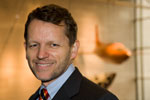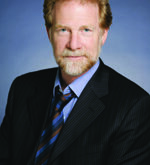 This interview originally appeared in the MIPTV 2011 issue of TV Real.
This interview originally appeared in the MIPTV 2011 issue of TV Real.The Smithsonian Institution is an American treasure. As the world’s largest museum and research complex, with 19 museums, nine international research centers and 168 million artifacts, it covers a huge range from history and art to space and technology, even pop culture. The Smithsonian Channel, a joint venture between the Smithsonian and Showtime Networks, taps into this rich selection of subject matter to craft entertaining and informative programming. David Royle, the network’s executive VP of programming and production, tells us how.
TV REAL: The Smithsonian Channel launched in 2007 and has been growing well. To what do you attribute its growth?
ROYLE: I think people actually feel a very emotional connection to the Smithsonian, and it’s not just a place; the Smithsonian brand is incredibly powerful. For a lot of Americans, and for people worldwide, it stands for real credibility, real depth, real thoughtfulness and exploration as well. So it’s a very exciting brand to be taking to television.
Then, of course, the other thing that helped us enormously was that we came in at the front of HD. From day one, we felt that producing television that was of the top quality level, full HD, 5.1 surround sound, was the way to go and fit the quality the brand brought with it.
Finally, I would say that the Smithsonian Channel is this interesting marriage between the Smithsonian and Showtime, which is part of CBS. From the Smithsonian, you get great DNA: you’ve got the credibility, the integrity and everything that the Smithsonian stands for, and the great stories that exist there. And then you have the entertaining side that Showtime and CBS bring to it. It’s no good doing programs if you don’t bring an audience to the door. And we set out to do programming that is truly entertaining, but also has credibility and is therefore informative.
TV REAL: How do you work with the Smithsonian Institution in creating your programming?
ROYLE: We work really closely with it. What people don’t always realize is just how big the institution is. It’s 19 separate museums, and it includes American History, Natural History, the National Zoo, a research station down in Panama, the
Hirshhorn [Museum and Sculpture Garden]. It’s this fantastic treasure trove of artifacts and, from our point of view, a treasure trove of stories. So, we work very closely with the curators and the scientists around the museums, and they put a certain number of story ideas to us every year, and we also look for stories that we just think are incredibly compelling.
Hirshhorn [Museum and Sculpture Garden]. It’s this fantastic treasure trove of artifacts and, from our point of view, a treasure trove of stories. So, we work very closely with the curators and the scientists around the museums, and they put a certain number of story ideas to us every year, and we also look for stories that we just think are incredibly compelling.
I’ll give you a couple of examples. One of our big films last year was Mystery of the Hope Diamond. This was a film that the Smithsonian Institution National Museum of Natural History was very keen for us to make because the Hope Diamond is one of those objects that is just magical and enormously compelling to people. It rivals the Mona Lisa at the Louvre every year as the most visited [art object]. In fact, there is an unspoken competition that takes place between the Louvre and the Smithsonian as to which object attracts the most visitors. The Hope Diamond has this great curse story. The Smithsonian has been doing ongoing science under the leadership of the curator Jeff Post, and it was the 50th anniversary of it being given to the Smithsonian, so we made a large film about it. And it combined all the best that we stand for: history, great science, a mystery and then a final destination at the Smithsonian.
TV REAL: Do you look to the international markets for programming when developing or acquiring programming?
ROYLE:Yes. We do an enormous amount of co-productions. We did Mystery of the Hope Diamond with Channel 4 in the U.K. and with NHK in Japan. The co-production model is absolutely vital to the way we’re building this channel, and it’s a very natural model for us. We, for instance, have an ongoing series called The Real Story, which takes very popular movies like Escape from Alcatraz or The Exorcist or Titanic, for example, and it tells the true historical story behind those movies. We’ve been doing that with Channel 5 and Blink Films out of London for the last three years and we’ve just now completed our first 15 episodes. And that’s been a very successful series for us, but also for British television and also for Canadian television—so, it’s a nice example of a co-production partnership.
TV REAL: In today’s multichannel world, is the future of the documentary a healthy one, or is it an endangered species?
ROYLE: Oh, no, this is not an endangered species in my opinion. It is totally reinventing itself. The evolution of the documentary goes at a colossal pace, and one of the things that we’re very conscious of is, you can’t just think of the documentary itself, you’ve also got to think of the multimedia environment. And we’re on Apple TV now. We have a terrific iPhone app, which is very, very popular. I suspect we’ll be on the iPad before you know it. I also think that there is always a human hunger to understand the world and everything that’s in it. At the Smithsonian, part of our job is the diffusion of knowledge, and I think the hunger exists out there in the audience.
My own feeling is that the documentary has evolved in many areas and it has become very exciting in the way it’s presented; but it has also become detached at times from real reality. You’re seeing some terrific reality-type shows, but they’re often created. We want to present programming that is rooted in actual life. That’s part of what we do. We want to capture the drama, the excitement, the entertaining side of life, but we want it to be true to what goes on.
ADVERTISEMENT
